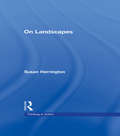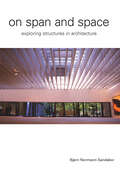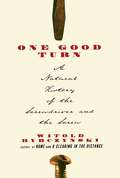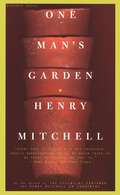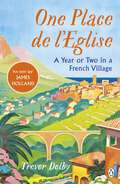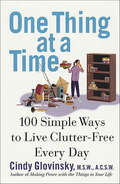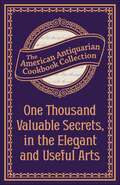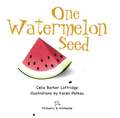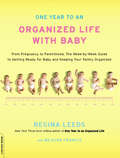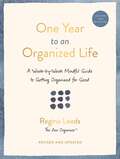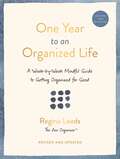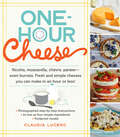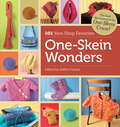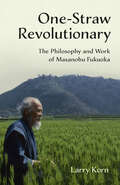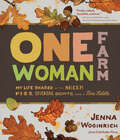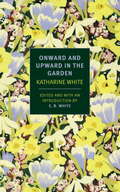- Table View
- List View
On Flowers: Lessons from an Accidental Florist
by Amy MerrickA singular, personal celebration of the beauty and possibilities of nature Amy Merrick is a rare and special kind of artist who uses flowers to help us see the familiar in a completely new way. Her gift is to revel in the unexpected—like a sunny spring arrangement housed in a paper coffee cup—and to overturn preconceptions, whether she’s transforming a bouquet of supermarket carnations into a breathtaking centerpiece or elevating wild and weedy blooms foraged from city sidewalks. She uses the beauty that is waiting to be discovered all around us—in leaves, branches, seedpods, a fallen blossom—to tell a story of time and place. Merrick begins On Flowers with a primer containing all her hard-won secrets on the art of flower arranging, from selecting materials to mastering pleasing proportions. Then she brings readers along on her journey, with observations on flowers in New York City and at her family’s summer home in rural New Hampshire, working on a flower farm off the coast of Washington State, and studying ikebana in a jewel-box flower shop in Kyoto. We learn how to send flowers like a florist, and how to arrange them like a farm girl. We discover the poignancy in humble wildflowers, and also celebrate the luxury of fragrant blousy blooms. Collected here is an anthology of floral inspiration, a love letter to nature by an exceptional, accidental florist.
On Landscapes (Thinking in Action #29)
by Susan HerringtonThere is no escaping landscape: it's everywhere and part of everyone's life. Landscapes have received much less attention in aesthetics than those arts we can choose to ignore, such as painting or music – but they can tell us a lot about the ethical and aesthetic values of the societies that produce them. Drawing on examples from a wide range of landscapes from around the world and throughout history, Susan Herrington considers the ways landscapes can affect our emotions, our imaginations, and our understanding of the passage of time. On Landscapes reveals the design work involved in even the most naturalistic of landscapes, and the ways in which contemporary landscapes are turning the challenges of the industrial past into opportunities for the future. Inviting us to thoughtfully see and experience the landscapes that we encounter in our daily lives, On Landscapes demonstrates that art is all around us.
On Span and Space: Exploring Structures in Architecture
by Bjorn N. SandakerIn this richly illustrated book with many practical examples, Bjorn Sandaker provides readers with a better understanding of the relationship between technology and architecture. As an experienced teacher and writer, Sandaker offers a well-founded aesthetic theory to support the understanding and evaluation of a structure's form and design, examining concepts and viewpoints from both the professions of engineering and architecture. Comprehensively covering structure and aesthetics, this book is ideal for students, professionals and academics in the areas of architecture and building.
On The Farm
by Julie FerrisAll over the world, farmers are hard at work. Some farmers grow and harvest grain, vegetables, fruit, and flower crops. Other farmers raise animals such as sheep, goats, and cows for wool, meat, and milk. Farmers in different regions of the world often produce different things. Meet three farmers with very different farms. Don Josè raises sheep, Mary runs a dairy farm, and Ben grows vegetables. Find out what happens on a busy day on their farms.
On Your Own Instructional Booklet: A Personal Budgeting Simulation
by Mary Queen DonnellyThis simulation depicts a recent high school graduate finding out what it means to be On Your Own financially. The text presents the process of opening a checking account, renting an apartment, applying for credit, looking for a job, buying a car, and paying taxes. Students complete parallel activities for themselves as they work through the text, completing budgets and creating filing systems for personal financial information. As the graduate learns what it means to be on your own, so will your students.
One Good Turn: A Natural History of the Screwdriver and the Screw
by Witold RybczynskiThe Best Tool of the Millennium The seeds of Rybczynski's elegant and illuminating new book were sown by The New York Times, whose editors asked him to write an essay identifying "the best tool of the millennium." The award-winning author of Home, A Clearing in the Distance, and Now I Sit Me Down, Rybczynski once built a house using only hand tools. His intimate knowledge of the toolbox -- both its contents and its history -- serves him beautifully on his quest. One Good Turn is a story starring Archimedes, who invented the water screw and introduced the helix, and Leonardo, who sketched a machine for carving wood screws. It is a story of mechanical discovery and genius that takes readers from ancient Greece to car design in the age of American industry. Rybczynski writes an ode to the screw, without which there would be no telescope, no microscope -- in short, no enlightenment science. One of our finest cultural and architectural historians, Rybczynski renders a graceful, original, and engaging portrait of the tool that changed the course of civilization.
One Little Lot: The 1-2-3s of an Urban Garden
by Diane C. MullenIn a bustling, urban neighborhood, count the ways one little lot becomes a beautiful community vegetable garden.Count all the ways (one to ten) an urban community unites to clean up an abandoned lot. From building planter boxes to pulling weeds to planting seeds, everyone works together to transform the lot into a bountiful vegetable garden. As the garden grows, strangers become friends, eventually sharing in a special feast with the harvest they grew.
One Magic Square Vegetable Gardening: The Easy, Organic Way to Grow Your Own Food on a 3-Foot Square
by Lolo HoubeinAll it takes to grow your own organic vegetables, fruits, and herbs is One Magic Square Lolo Houbein has 40 years’ worth of gardening wisdom to share—on how to coax an abundance of organic food from a plot that is just 3 feet square!Sustainable, cost-effective, and creative techniques: how to compost, save water, troubleshoot weeds and pests, create a plant-friendly microclimate, and moreOver 40 themed plot designs, from antioxidant-rich and anti-cancer plots to salad, pizza, pasta, and stir-fry plotsEncyclopedic information about every crop in every plotTips on drying, freezing, pickling, and other ways to get more value and enjoyment from your homegrown produceAnd her irresistible gardening philosophy (“If herbs wanted to be used frugally, they would also grow frugally. But they don’t!”) Ever encouraging, often charming, and always practical, this expanded second edition of One Magic Square Vegetable Gardening will help first-time gardeners get started—and help veteran gardeners get results—on a small, easy-to-maintain plot. No actual magic is required!
One Magic Square: The Easy, Organic Way to Grow Your Own Food on a 3-Foot Square
by Lolo HoubeinA Hands-On Guide to Growing Organic Vegetables, Fruits and Herbs—Starting with Just One Square Yard!Lolo Houbein has been growing food for more than 30 years—and now, drawing on her wide learning and hard-earned experience, she offers a wealth of information on how to turn small plots of land into sources of nourishing, inexpensive, organic food. Amateur gardeners wondering how to get started and veteran gardeners looking for new ideas will be inspired by Houbein’s practical, often charming, and always optimistic advice. One Magic Square includes:Earth-friendly tips, tricks, and solutions for establishing and maintaining an organic gardenIllustrated, annotated plans for 30 plots with different themes—including perennials and “pick-and-come-again” plants, anti-cancer and anti-oxidant-rich vegetables, and salad, pizza, pasta, and stir-fry ingredientsComprehensive information about every plant in every plotColor photographs of the author’s own garden—plus helpful illustrationsHoubein family recipes for making the most of your bounty—including salad dressings, fruit and vegetable juices, stir-fries, and more.
One Man and His Dig
by Valentine LowA funny and original look at the various crops and characters the author encountered during his years tending a west London allotment.
One Man's Garden
by Henry MitchellIn the sequel to The Essential Earthman, the Washington Post columnist offers a harvest of sharp observations and humorous adventures gathered during a year in his garden, along with much down-to-earth advice on horticulture.
One Place de l’Eglise: A Year in Provence for the 21st century
by Trevor DolbyEscape to Languedoc in this poignant and transportative true account of life in a beautifully restored house in the south of France'Wonderful, exquisitely written, laugh-out-loud funny, profoundly moving. An utter joy and a treat to read from first to last' JAMES HOLLAND'Dolby writes with genuine emotion. He writes beautifully about life in a French village' DAILY MAIL___________An Englishman's home is his castle. But what if it's French?One Place de L'Eglise is a thousand-year-old Languedoc ruin. Leaky, crumbling, lacking basic amenities, it is ignored by the local villagers. But for Londoners Trevor and Kaz it is love at first sight. Over the years they turn the house into a home, navigating floods and freezing winters. Here, these two English find their place - their bar, their baker, their builder (ignore him at your peril).And gradually they learn slower joys - scents of thyme and lavender, warm sun on stone, nights hung with stars, silence in the hills, the secrets of fig jam.One Place de L'Eglise is a love letter - to a house, a village, a country - from an outsider who discovers you can never be a stranger when you're made to feel so at home.___________'Irresistible, a timeless story' MICHAEL PALIN 'Elegant, captivating, and sprinkled with self-deprecating humour. Dolby is a writer of abundant talent' PETER KERR, author of Snowball Oranges
One Thing at a Time: 100 Simple Ways to Live Clutter-Free Every Day
by Cindy GlovinskySimple, effective ways to put things in their place from the therapist, professional organizer, and author of Making Peace with the Things in Your Life.Those piles of papers, clothes, and other things you thought you’d successfully de-cluttered have returned, and this time they brought friends. What’s the use of trying to fight the clutter? Is there a better way?This powerful and useful guide delivers solutions that work, no matter how overwhelmed you feel. The answer isn’t an elaborate new system, or a solemn vow to start tomorrow. Instead, psychotherapist and organizer Cindy Glovinsky shares 100 simple strategies for tackling the problem the way it grows—one thing at a time. Here’s a sampling of the tips explained in the book:Declare a fix-it dayPurge deep storage areas firstLabel it so you can read itGet a great letter openerPractice toy population planningLeave it neater than you found itWritten in short takes and with a supportive tone, this is an essential, refreshing book that helps turn a hopeless struggle into a manageable part of life, one thing at a time.Praise for Making Peace with the Things in Your Life“Glovinsky is a compassionate, talented organizer who understands the root causes of people’s clutter woes. This is a really helpful book.” —Judith Kolberg, author of Conquering Chronic Disorganization and coauthor of ADD-Friendly Ways to Organize Your Life“Glovinsky asks readers to examine the underlying psychological issues that they have with things . . . She takes Julie Morgenstern’s Organizing from the Inside Out to the next level.” —Library Journal
One Thousand Valuable Secrets, in the Elegant and Useful Arts: Collected from the Practice of the Best Artists and Containing an Account of the Various Methods
by Antiquarian Collection CookbookOriginally published in London in 1775, One Thousand Valuable Secrets was Americanized and published in Philadelphia in 1795 in an effort to help the newly established United States become self-sufficient from Europe. As stated in the preface, the purpose of the American edition was to &“promote industry and stimulate genius&” and will hopefully have been &“received as an acceptable contribution.&” Covering everything from engraving, &“break[ing] an iron bar as big as the arm,&” and making varnishes to imitating precious stones, preparing dyes, gilding, brewing, cooking, and creating molds, One Thousand Valuable Secrets &“will be equally profitable to every reader, who wishes to be acquainted with a number of curious and useful receipts, applicable to the common occasions of life.&” With its one thousand different instructions for practical and helpful arts, this weighty tome has both cultural significance in the information it provides and historical significance in its purpose of helping the United States become truly independent in its economy and culture. This edition of One Thousand Valuable Secrets, in the Elegant and Useful Arts was reproduced by permission from the volume in the collection of the American Antiquarian Society, Worcester, Massachusetts. Founded in 1812 by Isaiah Thomas, a Revolutionary War patriot and successful printer and publisher, the society is a research library documenting the lives of Americans from the colonial era through 1876. The society collects, preserves, and makes available as complete a record as possible of the printed materials from the early American experience. The cookbook collection comprises approximately 1,100 volumes.
One Thousand Valuable Secrets, in the Elegant and Useful Arts: Collected from the Practice of the Best Artists and Containing an Account of the Various Methods
by Antiquarian Collection CookbookOriginally published in London in 1775, One Thousand Valuable Secrets was Americanized and published in Philadelphia in 1795 in an effort to help the newly established United States become self-sufficient from Europe. As stated in the preface, the purpose of the American edition was to &“promote industry and stimulate genius&” and will hopefully have been &“received as an acceptable contribution.&” Covering everything from engraving, &“break[ing] an iron bar as big as the arm,&” and making varnishes to imitating precious stones, preparing dyes, gilding, brewing, cooking, and creating molds, One Thousand Valuable Secrets &“will be equally profitable to every reader, who wishes to be acquainted with a number of curious and useful receipts, applicable to the common occasions of life.&” With its one thousand different instructions for practical and helpful arts, this weighty tome has both cultural significance in the information it provides and historical significance in its purpose of helping the United States become truly independent in its economy and culture. This edition of One Thousand Valuable Secrets, in the Elegant and Useful Arts was reproduced by permission from the volume in the collection of the American Antiquarian Society, Worcester, Massachusetts. Founded in 1812 by Isaiah Thomas, a Revolutionary War patriot and successful printer and publisher, the society is a research library documenting the lives of Americans from the colonial era through 1876. The society collects, preserves, and makes available as complete a record as possible of the printed materials from the early American experience. The cookbook collection comprises approximately 1,100 volumes.
One Watermelon Seed
by Celia Barker LottridgeIn this deceptively simple counting book, Max and Josephine tend their garden while readers follow along, counting from one to ten as the garden is planted. Then readers can count in groups of tens as the garden is harvested, while they search through the pictures for the many small animals that are hiding throughout. A concise and clever text introduces color and rhythm, and the illustrations are bright and engaging, making this a perfect counting book for children aged four to seven.
One Year to an Organized Life with Baby: From Pregnancy to Parenthood, the Week-by-Week Guide to Getting Ready for Baby and Keeping Your Fami
by Meagan Francis Regina LeedsFrom the "New York Times"?bestselling author of "One Year to an Organized Life," a month-by-month guide to organizing your life during pregnancy and after your babyOCOs arrival"
One Year to an Organized Life: A Week-by-Week Mindful Guide to Getting Organized for Good
by Regina LeedsA comprehensive, week-by-week bible to completely streamline all aspects of your life—now revised & updated for a global pandemic world of working from home and learning to de-stress while you de-clutter. Who would you be if you felt at peace and had more time and money? An organized life enables you to have more freedom, less aggravation, better health, and to get more done. Regina Leeds has helped even the messiest turn their lives around. One Year to an Organized Life is a unique week-by-week approach that you can begin at any time of year. Regina helps you break down tasks and build routines over time so that life becomes simple, not overwhelming. Whether you're living in chaos or just looking for new ways to simplify, this essential book will help you get the whole household organized-and stay that way. Covid has shaken humanity to the core and forced us to slow down and reimagine the way we use our living spaces. In a flash, the space we knew simply as home was suddenly a classroom, our office and the gym. And, at a time when stress and anxiety is at an all-time high, it no longer seems odd to meditate. It feels life-saving. If life is to be re-imagined, shouldn&’t we also do that with our living spaces? In this revised and updated edition of One Year to an Organized Life, Regina Leeds reveals how to optimize your space—for work, family and daily calmness (with plenty of new affirmations and reward systems built into her organizing tips).
One Year to an Organized Life: From Your Closets to Your Finances, the Week-by-Week Guide to Getting Completely Organized for Good
by Regina LeedsWho would you be if you felt at peace and had more time and money? An organized life enables you to have more freedom, less aggravation, better health, and to get more done. For nearly twenty years, Regina Leeds-named Best Organizer by Los Angeles magazine-has helped even the messiest turn their lives around. Anyone can get organized-she’ll prove it to you! One Year to an Organized Life is a unique week-by-week approach that you can begin at any time of year. Regina helps you break down tasks and build routines over time so that life becomes simple, not overwhelming. Master time management Make your kitchen efficient Permanently organize closets and drawers Deal with your finances Reclaim "dumping grounds” like the guest room, garage and basement Declutter the kids’ rooms Organize your travel plans-and the vacation photos and souvenirs Entertain with joy Regina reveals her magic formula for organizing anything, plus her method to stop the chronic cycles of clutter, misplaced items, and lateness. Whether you’re living in chaos or just looking for new ways to simplify, this essential book will help you get the whole household organized-and stay that way.
One-Hour Cheese: Ricotta, Mozzarella, Chèvre, Paneer--Even Burrata. Fresh and Simple Cheeses You Can Make in an Hour or Less!
by Claudia LuceroIt’s a DIY cook’s dream come true: It’s pizza night, and you’ve made not only the crust and sauce but the mozzarella, too. Or you're whipping up quesadillas for a snack, using your homemade Triple Pepper Hack. Or the dinner party's in high gear and out comes the cheese plate—and yes, you've made all the cheeses on it. Even better—you made them all earlier that day. In a cookbook whose results seem like magic but whose recipes and instructions are specific, easy-to-follow, and foolproof, Claudia Lucero shows step by step—with every step photographed—exactly how to make sixteen fresh cheeses at home, using easily available ingredients and tools, in an hour or less. The approach is basic and based on thousands of years of cheesemaking wisdom: Heat milk, add coagulant, drain, salt, and press. Simple variations produce delicious results across three categories—Creamy and Spreadable, Firm and Chewy, and Melty and Gooey. And just as delicious, the author shows the best ways to serve them, recipes included: Squeaky “Pasta” Primavera, Mozzarella Kebab Party, and Curry in a Hurry Lettuce Wraps.
One-Skein Wonders®: 101 Yarn-shop Favorites (One-Skein Wonders)
by Judith DurantIf you’re like most knitters, you have lonely skeins of yarn in your closet — casualties of projects discarded mid-row or leftovers from long-completed pieces. Offering 101 charming designs that use just a single skein of yarn, Judith Durant shows you how to turn these extra bits of fiber into stylish hats, mittens, scarves, and tea cozies. Covering a wide range of tastes and styles, this collection will inspire you to dig out your orphan yarn and get stitching.
One-Straw Revolutionary: The Philosophy and Work of Masanobu Fukuoka
by Larry KornOne-Straw Revolutionary represents the first commentary on the work of the late Japanese farmer and philosopher Masanobu Fukuoka (1913 – 2008), widely considered to be natural farming&’s most influential practitioner.Mr. Fukuoka is perhaps most known for his bestselling book The One-Straw Revolution (1978), a manifesto on the importance of no-till agriculture, which was at the time of publication a radical challenge to the global systems that supply the world&’s food, and still inspires readers today. Larry Korn, who apprenticed with Mr. Fukuoka in Japan at the time, translated the manuscript and brought it to the United States, knowing it would change the conversation about food forever. The One-Straw Revolution, edited by Korn and Wendell Berry, was an immediate international success, and established Mr. Fukuoka as a leading voice in the fight against conventional industrial agriculture. In this new book, through his own personal narrative, Larry Korn distills his experience of more than thirty-five years of study with Mr. Fukuoka, living and working on his farm on Shikoku Island, and traveling with Mr. Fukuoka to the United States on two six-week visits. One-Straw Revolutionary is the first book to look deeply at natural farming and intimately discuss the philosophy and work of Mr. Fukuoka. In addition to giving his personal thoughts about natural farming, Korn broadens the discussion by pointing out natural farming&’s kinship with the ways of indigenous cultures and traditional Japanese farming. At the same time, he clearly distinguishes natural farming from other forms of agriculture, including scientific and organic agriculture and permaculture. Korn also clarifies commonly held misconceptions about natural farming in ways Western readers can readily understand. And he explains how natural farming can be used practically in areas other than agriculture, including personal growth and development.The book follows the author on his travels from one back-to-the-land commune to another in the countryside of 1970s Japan, a journey that eventually led him to Mr. Fukuoka&’s natural farm. Korn&’s description of his time there, as well as traveling with Mr. Fukuoka during his visits to the United States, offers a rare, inside look at Mr. Fukuoka&’s life. Readers will delight in this personal insight into one of the world&’s leading agricultural thinkers.&“A profound sharing of the essential philosophy of natural farming translated through the friendship between Larry Korn and Masanobu Fukuoka. . . [It] offers wise insights into authentic practices that honor the community of all life.&”—Katrina Blair, author of The Wild Wisdom of Weeds
One-Woman Farm: My Life Shared with Sheep, Pigs, Chickens, Goats, and a Fine Fiddle
by Jenna WoginrichIn this inspiring memoir, Jenna Woginrich reflects on the joys, sorrows, trials, and blessings discovered through a year of homesteading. With eloquent prose, delightful illustrations, and inspiring snippets of poetry, Woginrich revels in the unique charms of each season on the land. Full of poignant observations and fascinating tidbits of farming lore, this book is a heartfelt testament to the deep fulfillment one can find in the practical tasks and timeless rituals of an agricultural life.
One-Yard Wonders: 101 Sewing Fabric Projects; Look How Much You Can Make with Just One Yard of Fabric! (One-Yard Wonders)
by Patricia Hoskins Rebecca YakerDiscover all that you can make with just one yard of fabric! Rebecca Yaker and Patricia Hoskins offer 101 fun projects that use a single yard of fabric to make clothes, accessories, baby items, and more. With clear, step-by-step instructions, each project is designed to be completed in just a few hours. Get inspired and turn a yard of your favorite fabric into a quilted lunch bag, bright sundress, or a cuddly plush turtle.
Onward and Upward in the Garden
by E. B. White Katherine S. WhiteIn 1925 Harold Ross hired Katharine Sergeant Angell as a manuscript reader for The New Yorker. Within months she became the magazine's first fiction editor, discovering and championing the work of Vladimir Nabokov, John Updike, James Thurber, Marianne Moore, and her husband-to-be, E. B. White, among others. After years of cultivating fiction, White set her sights on a new genre: garden writing. On March 1, 1958, The New Yorker ran a column entitled "Onward and Upward in the Garden," a critical review of garden catalogs, in which White extolled the writings of "seedmen and nurserymen," those unsung authors who produced her "favorite reading matter." Thirteen more columns followed, exploring the history and literature of gardens, flower arranging, herbalists, and developments in gardening. Two years after her death in 1977, E. B. White collected and published the series, with a fond introduction. The result is this sharp-eyed appreciation of the green world of growing things, of the aesthetic pleasures of gardens and garden writing, and of the dreams that gardens inspire.

